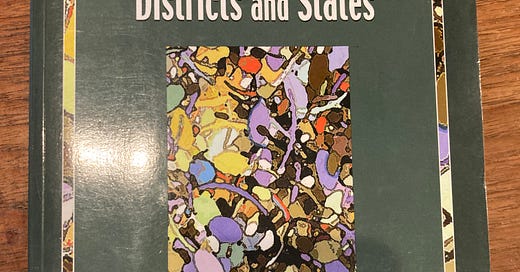Rustlings of interest in the ancient arts of the portfolio are being heard from Portland east to Portland west, though they are faint stirrings. Many of us who worked on portfolios during the Golden Age have come to believe the seeds we planted in the already fertile fields of reflective practice back when language was whole and literature was core were left to rot in the ground.
I wrote my dissertation on portfolio assessment and published a mixed methods study in a journal and in a book. I even won a Promising Researcher award from NCTE. Lately, I’ve gotten wind of a purchase of the book I wrote based on the study from Amazon, the first sale I’ve learned about for two decades. Portfolio practices were central in school reform during the 1990s. In the blink of an eye, things went dark.
When the lower-case ‘e’ was affixed to the truncated ‘folio,’ any serious interest in reflective practice was subjugated to an intense focus on ‘digital platforms.’ In my role as a teacher, professional developer, consultant, and writer, I watched, detached and depressed, as discussions of TaskStream or eFolio Minnesota, etc., drowned out discussions of portfolio instruction.
The portfolio was reduced to a container once again—the ‘eFolio’ a really nice container because students could turn in assignments online and make it that much easier to grade. Digital technologists had portfolios in their wheelhouse. Portfolios are far more then envelopes or files or websites.
The following questions are real. A friend and colleague is responding to feelers sent out from a large metropolitan school district. Someone with administrative responsibilities is interested but has a lot of questions. Because I think these questions represent the times, I decided to offer my responses here for better or for worse.
***
Q1: Teachers and leaders are overwhelmed, overextended, and in some cases burned out. Given our current context, why should schools even consider implementing student portfolios?
This question almost brings tears to my eyes. I have no doubt if public schools had taken up and institutionalized reflective practices supported by portfolios and related documentation practices, especially adding the ‘e,’ the devastating consequences for learning in the pandemic, especially among poor and marginalized children, could have been mediated a bit. If the ‘e’ fascination had instead drilled down on pedagogy and assessment in a digital environment as things seem to be going now, schools would have been already using digital affordances effectively with two decades of experience.
The biggest reason schools should be interested in portfolios now is expressed in the question: Because teachers and leaders are in a tight spot, they should look to better ways to reach children. The answers to our problems are always found in our children, though adults are often too arrogant to embrace this possibility.
2. What should portfolios be for?
Portfolios are a bridge between past experience and future hopes. Portfolios have a shaping influence on the here and now by insisting that what we do now is an extension of the past and a promise for a future. We make better decisions and learn more in the moment when our habit of mind is that of a documentarian. This is why we have medical records.
3. Who should portfolios be for?
Primarily, they are for children. Because they help motivate and organize children, because they engage children in participating in their own learning and its assessment, they strengthen learning. They help adults charged with educating them by inviting them into sustained learning. Portfolios children make are ruined if they are made entirely for adults and their need for accountability. Nonetheless, perhaps paradoxically, donevwell, they strengthen accountability.
4. Are portfolios only an assessment tool, or can they serve as an instructional resource? If the latter, how so?
No, yes, and let’s talk. I have a couple of books on that. Far better minds than mine have written volumes as well, some of which I’ve read.
5. In a perfect educational world...if portfolios are the solution, what is the problem?
I’m not sure how to respond. We are not in a perfect educational world. Portfolios will not make things perfect. Becoming an instructional culture infused with portfolio practices can improve opportunities to learn. The problem of teaching the next generation, like the problem of democracy, must be solved anew with each generation.
6. Thinking more about overwhelmed teachers and leaders, can we take anything off their plates as they implement student portfolios? What might portfolios supplant?
Portfolios by nature take things off of teachers’ plates. They make it easier for teachers to learn their students’ interests/prior knowledge and confidence/competence levels, aspects that make lesson planning more effective and purposeful. Time spent shooting in the dark or fumbling around with publisher’s manuals is left off the proverbial plate.
You won’t make headway with portfolios if these practices are viewed as just another job to do. That said, it requires a lot of work to design and implement a system. I’d advise you to make a five year plan,
7. What barriers can portfolios help break down for students between school life and reality beyond formal education?
None. They can provide a habit of mind that gives students tools to break down barriers. Teachers can do a lot to break down barriers by inviting reality beyond formal education as a legitimate matter into the curriculum. Portfolio practices can help there.
They can’t change reality, but they can change formal education. It may be worth thinking about barriers between reality and formal education erected by formal education and then see how portfolio practices can chip away at them. John Dewey would remind us that schooling is reality for children. Portfolios done well can break down barriers between children and the reality of the formal school.



